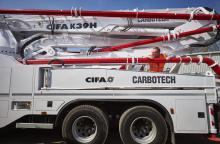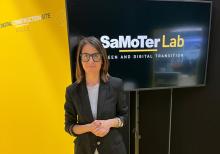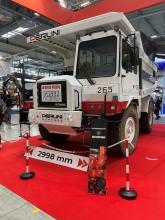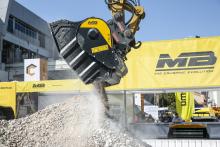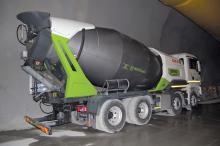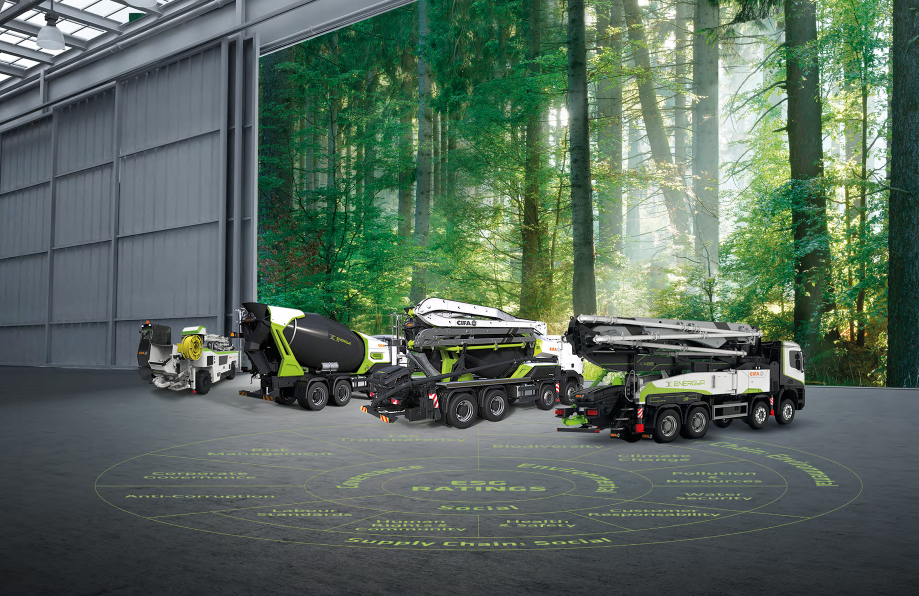
An early adopter of construction industry solutions addressing climate change and environmental sustainability, CIFA unveiled Energya, the world's first battery-powered electric concrete mixer, at bauma 2013. Based on years of research and development, Energya's ground-breaking technology incorporates battery electric equipment (BEE) capable of operating without external energy sources. In traditional concrete mixers, the movement of the drum is generated by a hydraulic system; in the Energya mixer, known as E9, it is generated by an electric induction motor receiving energy from a lithium-ion battery.
Energya created a new paradigm by profoundly changing the concept of the truck mixer by making it independent of the truck. The movement of the drum is driven directly by an electric motor. The latter has also replaced the group of hydraulic pumps, simplifying the structure of the kit. This system, combined with the characteristics of the 28.1kW/100Ah lithium-ion battery pack, is said by CIFA to guarantee autonomy throughout the working day. In addition, the KERS (Kinetic Energy Recovery System) device also ensures a constant balance of the battery charge during transfer by exploiting the energy recovered during the braking phase.
All the information relating to the CIFA Energya truck mixer's state of use and operation can be checked at all times on the monitor installed in the driving cab of the truck and at the back of the vehicle. The system is compatible with both 220V and 380V outlets. Charging times vary from eight hours with a standard system, reduced by up to one hour if the CIFA-designed column is used. Since 2013, CIFA's R&D department has continued working on new electric models: the CSSE shotcrete pump, the MK28E concrete pump, and the new K42E pump, presented at bauma 2022.
Speaking to Aggregates Business on the third day of SaMoTer 2023, CIFA's Marco Polastri explains that the company's sustainability-minded Energya solutions take their cue from aviation design, combining ruggedness and functionality with globally admired Italian design. For example, the Energya K42E pump's boom extends up to 42 metres in five sections, with the last two in carbon fibre: a novel feature of CIFA's CARBOTECH range and a smart way of optimising the machine's weight without reducing strength and reliability. It is equipped with a state-of-the-art system that uses a 30 amp hour cell battery pack to power two electric motors; the first drives the hydraulic pump to move the boom and open the outriggers, while the second drives the pumping unit (with a closed circuit and maximum capacity of 160m³/hour at 80 bar) and other services.
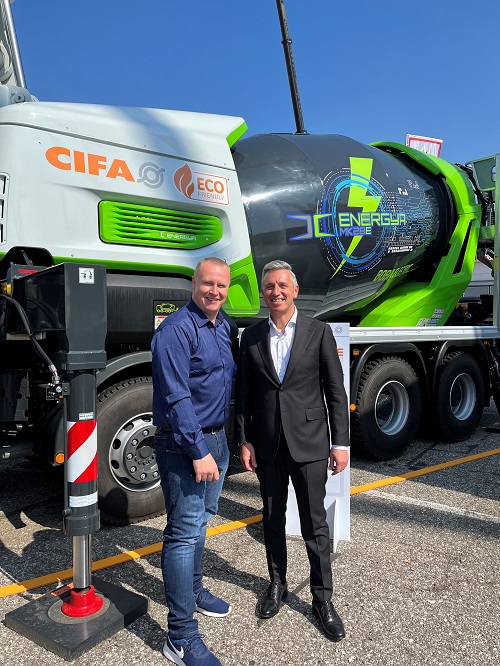
If the job requires higher performance than the batteries can provide, the new Energya pump must be connected directly to an electrical outlet on site. The system will cut out the batteries and power the electric motors directly. This means the system will continue to operate without the truck's diesel engine, resulting in no exhaust gas and low noise emissions. In the case of a complete lack of electrical sources, an emergency system allows you to connect the K42E to the truck's power take-offs, use the engine to complete the work and close the boom and outriggers. The charging process is quick and easy, and the integrated battery charger is compatible with the 220V system.
Commenting on CIFA's global market trading, Polastri says: "2021 and 2022 were exceptional years for us, and the strength of our trading has continued this year in our major markets of Europe, North America and the Middle East. The outlook is also positive for 2024. We know of the big challenges, including interest rates, energy costs and a supply chain still not working properly, affecting lead times and deliveries, but product demand is very strong. The post-COVID agenda is fuelling much government spending on big infrastructure to keep economies going, creating great interest in high-spec, bigger machines like many of ours. We are capable of quickly adapting to market changes."
Polastri says of CIFA's sustained focus on innovation: "In the last few years, we have released an 'Industry 2.0 version' of our product range in a modular design. Since its founding, CIFA has been driven by innovation. Most of our budget has gone into product development. While we have a wide range of products that can cater to any application need, concrete machinery does not enjoy the same [sales] volumes as earthmoving machinery. So, to address sustainability, we redesigned our range modularly. We introduced the same sub-frames for different product families and made more standardised boom sections. This makes servicing and parts replacement quicker and easier."
In the last three years, CIFA's production capacity has increased by 15-20% every year, notes Polastri. "This is a good increase. All four of our production plants are in Italy, and we have a large global supply chain, some of which are based in China, as CIFA is part of the Zoomlion Group. This change is based on our long-term market outlook but has also been done with production flexibility in mind.
"We offer a full concrete machinery product range: from batching plants to truck-mixer transportation and pumping. We want to be a one-stop shop for our customers."
Polastri says CIFA is also trying to diversify its sales territories. "CIFA is very busy across Europe and is present globally. We do not have the same presence in the Americas, the Middle East and Africa, so we are investing in distribution platforms and assembly plants in North America and the Middle East. We have a long and aggressive investment plan that we kept going even when the global market was not so good, such as during the COVID pandemic."
Zoomlion fully acquired CIFA in 2008, and I am interested to know how much influence the Chinese off-highway machinery major has on the Italian firm's business. "There is big trust from Zoomlion senior management in China," explains Polastri. "CIFA is playing a big product development role within Zoomlion, so our Italian engineering team is also playing a big part in developing some of Zoomlion's lifting machinery and some of the Zoomlion-branded concrete machinery coming out of Italy. Zoomlion has invested in our Italian-based R&D team, which has given CIFA big strength. The Italian government has also recognised Zoomlion as one of the 'Best in Class' foreign investors in Italian industry."
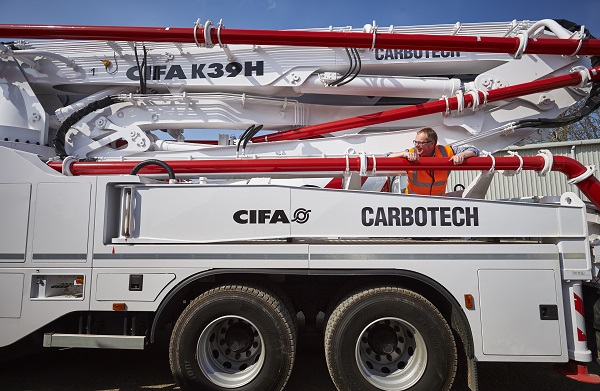
Polastri explains that CIFA works with exclusive dealers worldwide, except in key large markets such as the USA, France and Germany, where CIFA operates sales, aftersales, and in some cases, machinery-assembly-inclusive subsidiaries. "This works well. For example, in Germany, a very competitive [concrete truck mixer and pump] market, we take everything ourselves to ensure good results. Italy is our domestic market, where we are the market leader. The country is benefitting from a very big contribution from the [€190bn-plus] NextGenerationEU program, and the national government is emphasising Industry 4.0 digitalisation, with many [construction, building contractor and infrastructure project] companies renewing their machines. This creates good commercial opportunities. We saw 30% [sales] growth [in Italy] last year and are seeing pretty good growth again in Italy this year."
Whereas much past national and international government investment in regional and individual country infrastructure was based on stimulating economic growth, Polastri notes that much new investment is linked to improving sustainability and encouraging a green circular economy. "Some new financial incentive packages within the Italian construction sector, for example, have this circularity in mind, with greater contractor fleet efficiency and lower energy-using buildings. It creates a win-win for all the stakeholders in a building project.
"In our [concrete] industry, transportation and pumping is a small part of the chain. We can do a lot around that with our products, but it remains at the end of the chain. The biggest CO2 emissions come from cement production and concrete mixing and preparation, which we do not control."
Polastri says CIFA has invested heavily in digitalisation resulting in CIFA VISTA, the company's 2021-launched remote machine monitoring system. This service uses a control unit that collects machine data and transmits them to the portal created via a supplied data-only sim card.
From what CIFA describes as a simple and intuitive interface, users can monitor their machine fleets' position, activities and operating parameters to ease troubleshooting, plan preventative maintenance, and enable more informed aftersales support management.

"It enables all job site machines – concrete batching plants, trucks mixers and pumps – to talk to each other and be connected so you can track by cubic metre production from the batching plant to the work site," explains Polastri. "This optimises production and lowers your cost per cubic metre. Digitalisation like this also improves safety by reducing the number of things a fleet operator has to do.
"We have another system, CIFA CONNECT, launched last year. This is our aftersales portal where you can access all our products' technical documentation and order replacement parts. When you give operators proper digital tools, like a phone or tablet, they use them."
Just before our enjoyable and wide-ranging conversation finishes, Polastri reemphasises that digitalisation and the electrification of concrete machinery are the two biggest elements of the company's market strategy. "Of course, when hydrogen-powered machines come in, we will be there on that, too," he adds.
I leave Polastri mid-morning as CIFA's large outdoor stand at SaMoTer 2023 stand is full of exhibition attendees, with an on-show Energya electric concrete truck pump-mixer attracting particular attention (MK28E). After covering the first ten years of the market rollout of Energya-based products in my conversation with Polastri, I look forward to seeing the next big CIFA innovation emerge over the next decade.

